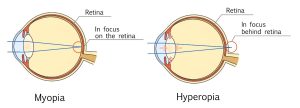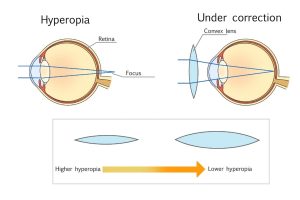Most babies are born with mild hyperopia, and as they grow up, their eyes grow and their visual acuity
develops until they reach about age 13. However, if the degree of hyperopia is severe, children often remain farsighted.
Children who are born with poor vision do not complain about it. Unlike myopia, this condition may not be evident on a vision test, but children whose eyes tire easily may also have trouble concentrating. It is important to be aware that hyperopia in children can lead to amblyopia and strabismus.
Amblyopia
Amblyopia is a condition where the development of vision is hindered and vision in one eye is reduced. Even with correction using glasses, vision does not improve to the desired level. Amblyopia occurs when a child grows up without being able to focus on the retina until around age 8, when vision develops.
A child with high hyperopia will always have blurred images even when the eye tries to focus, resulting in a lack of stimulation necessary for the development of visual acuity.
As the age of the child grows, vision development becomes more difficult, so early detection and early initiation of treatment is important.
*For more information on amblyopia, please click here.
Strabismus
Strabismus is when the eyes do not look in the same direction, for example when one eye looks straight ahead while the other looks in another direction. People with hyperopia tend to have both eyes turn inwards to accommodate, which can result in accommodative esotropia, where the pupils turn inwards.
Strabismus can cause impaired depth perception and double vision. If you have accommodative esotropia, you can correct it by wearing glasses to correct your hyperopia.
As with amblyopia, it is important to begin treatment as early as possible.
*For more information on strabismus, please click here.




